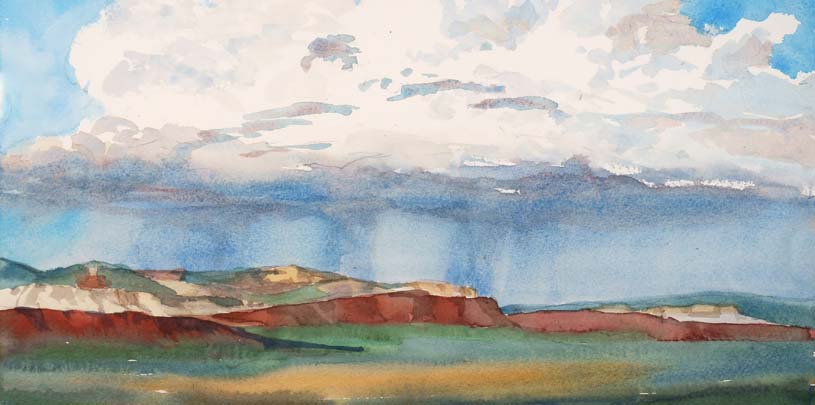
 by Kate Watters, former Volunteer Director
by Kate Watters, former Volunteer Director
“You need to have faith in the process,” Suze Woolf, Kane Ranch resident artist, says emphatically using her paintbrush to make the point. She’s leading a weekend watercolor workshop, and we are here to learn from one of the best.
Suze is a woman of exorbitant energy in a compact, athletic frame. A full-time, self-taught watercolor artist, she volunteered to drive herself from her home in Seattle to the middle of nowhere in House Rock Valley, take up residence at the remote 1877 Kane Ranch headquarters building, and get busy painting. In her 21 days at Kane, Suze finished 37 small paintings of the surrounding landscape.
She is true to her own teachings that “watercolor rewards boldness,” and we take her advice willingly in the remote hope that we will be able to bring the House Rock Valley and this eastern edge of the Grand Canyon alive like she has with a mere brush and paint.
We begin to follow her advice, squeezing our tubes of bright watercolor paints with names like “manganese blue hue” conservatively into our empty palettes. Suze encourages us to start playing with the bright dabs of color by generously wetting our brushes and letting one stroke of vermillion blend with turquoise.
Nature does not come out of a tube, Suze reminds us. Value is the skeleton and color is the flesh.
There is something electric about the white of the paper and the way the paint mixes itself. The colors that result at that intersection of water and unmixed color is surprising and organic.
Paraphrasing the artist Robert Irwin, Suze says, “Seeing begins when naming ends.” She encourages us to use 2” brushes that at first feel like I am trying to pick up marbles with a boxing glove. But indeed, the liveliness in our paintings increases as we let go of trying to exactly render the scene before us and instead express something personal about it. The looseness breaks open our skies, lighting up the crack that is Marble Canyon and making the grasslands dance.
We couldn’t have asked for more dramatic weather, but it certainly is not convenient for learning to paint. One day, the wind howls in 40 mile-per hour gusts while the sky spits out cold rain.
After several paintings and Suze’s patient tutoring, I feel like I am getting closer to being able to paint this enormous, emotionally charged sky and do it a tiny bit of justice. I learn that the sky is not just blue; it is made up of rose and purple and three kinds of blue and several other colors (even yellow)! When I look closely, I can see these colors in the three-dimensional stormy bellies I admire so much, especially as the sun fades and the clouds turn shades of rose and purple.
Art helps us fall in love with places. It charges them with emotion and meaning and reminds us why we care to protect them. When we get to study and paint these beloved cracks and monoclines, we infuse the paintings with our own selves.
The act of looking close and paying attention changes us as well. Each of our paintings of the Vermilion Cliffs was infused with personality and had a life of its own. We are reminded that in the process of making art, we cannot separate ourselves from it.
Driving back to Flagstaff with Rachel, a former Trust AmeriCorps intern, we both marvel at every changing shadow on a drive we have done countless times. She remarks that the weekend put her in a heightened state of awareness like she feels after a meditation retreat.
I have to agree. I cannot stop paying attention! The energy and passion Suze directs to her art is a lesson that applies to life. Like she said, “live shamelessly—you are in charge.”
Comments (1)
Leave A Comment